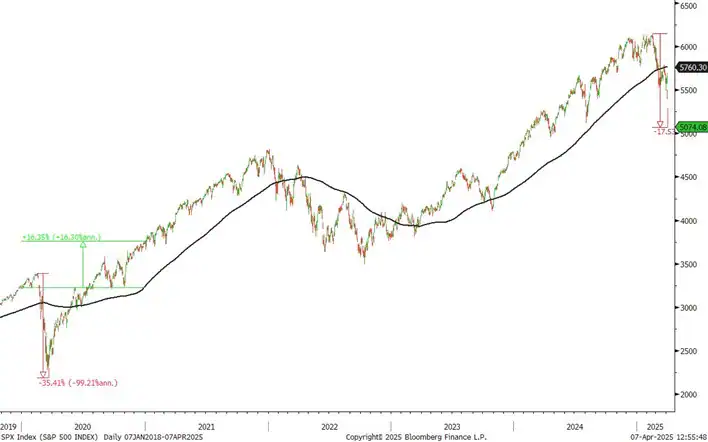Key points
-
Emotions are the enemy in volatile markets – Panic selling, overtrading, and chasing excessive safety often lead to poor outcomes. Instead, stay focused on your long-term plan and avoid knee-jerk reactions.
-
Use volatility to your advantage – Build a watchlist of high-quality ETFs, practice disciplined dollar-cost averaging, and rebalance when needed. These are simple, repeatable actions that can turn downturns into opportunity.
-
Stay informed and use your tools – From screeners to market updates and trade signals, Saxo offers everything you need to navigate market stress with confidence.
When markets get rocky, instincts often take over—and not in a good way. Volatility can trigger the kind of gut reactions that hurt portfolios more than help them. Whether it’s fear of losing money, frustration from watching gains evaporate, or the pressure to do something, investors often fall into familiar traps.
The good news? These mistakes are avoidable. Knowing what to look out for can be half the battle.
1. Panic selling: Turning volatility into a loss
One of the most common mistakes in a downturn is bailing out at the worst possible time. Selling when prices are falling might feel like cutting losses, but more often, it locks them in.
A better approach: Instead of reacting emotionally, ask: Has the long-term thesis changed? If not, it might be a time to hold—or even buy selectively. Markets have historically rewarded patience.
2. Market timing: The mirage of the perfect exit and entry
Trying to sidestep volatility by timing the perfect in-and-out? That’s a slippery slope. Missing just a few of the best rebound days can have a major impact on long-term returns.
A better approach: Dollar-cost averaging during choppy periods can help reduce regret and smooth out entry points. Staying invested—rather than guessing when to jump in—often leads to better outcomes.
3. Chasing “safe” assets: Flight to (too much) safety
In risk-off mode, many investors pile into cash or low-yielding assets. While there’s nothing wrong with dialing back risk, going too conservative can mean missing the rebound when it comes.
A better approach: Think of diversification as a shock absorber. Shifting some assets to more defensive sectors (like healthcare or utilities) or dividend stocks can reduce volatility while keeping you in the game.
4. Neglecting the plan: Strategy goes out the window
Volatile markets can make even seasoned investors second-guess their strategy. But changing your plan mid-storm is like redesigning a ship while sailing through a hurricane.
A better approach: If your investment plan is grounded in your goals and risk tolerance, trust it—especially when things feel shaky. Periodic rebalancing, not emotional reactions, should guide adjustments.
5. Overtrading: When activity masquerades as control
Market swings can tempt investors into frequent trades, hunting for quick wins or avoiding losses. But all that trading can rack up fees and tax consequences—not to mention stress.
A better approach: Sometimes the smartest move is no move at all. Focus on high-conviction ideas and long-term positioning rather than reacting to every headline or price swing.
What can investors do right now?
We compiled an Investor FAQ on the market downturn last month, packed with answers to the most common concerns: Should I sell? Are we at the bottom yet? What could be the signs of a turnaround? How do I know when it’s time to buy again?
Here’s how to stay proactive—and calm—in a volatile market:
1. Build a watchlist of high-quality ETFs
Volatility often presents great entry points into well-diversified vehicles. Here is how you can create a watchlist on SaxoTraderGo. Also, watch this video to create dynamic watchlists on SaxoTraderGo using the screener.
Some options to consider:
-
iShares Core S&P 500 UCITS ETF – Direct exposure to U.S. large caps.
-
Invesco Nasdaq-100 UCITS ETF – For those bullish on tech and growth stocks.
-
iShares Core MSCI World UCITS ETF – Global equity exposure.
-
Vanguard FTSE All-World UCITS ETF – Diversified global markets, including emerging markets.
-
Amundi MSCI USA Minimum Volatility Factor UCITS ETF – For those seeking lower-risk U.S. exposure.
-
SPDR S&P Euro Dividend Aristocrats UCITS ETF – For income-focused investors in Europe.
-
iShares China Large Cap UCITS ETF – For contrarian exposure to Chinese blue chips, many of which are still trading at discounts.
-
KraneShares CSI China Internet UCITS ETF – A play on China tech giants like Alibaba, Tencent, and Meituan.
2. Practice Dollar-cost averaging
Don’t wait for the perfect bottom. Invest regular amounts over time. This removes emotion and spreads your entry price—especially useful when markets are bouncing around.
3. Rebalance when necessary
Set up rebalancing alerts to flag when your allocations drift too far from target—say ±5%. This helps you trim stretched positions and add to underweights systematically.
4. Stay informed with in-platform research
Leverage screeners, market updates, and trade signal tools to evaluate new opportunities without chasing headlines.
5. Write down your investing plan
Even a short note can anchor you: “I’m investing for the next 10 years, targeting long-term growth. I accept short-term dips and rebalance yearly.” It’s surprisingly effective at calming nerves.
Reminder: What happened after the COVID crash?
A little perspective goes a long way. Let’s rewind to March 2020:
-
The S&P 500 dropped ~34% in just over a month
-
By August 2020, it had fully recovered
-
By end-2020, it finished the year up ~16%
-
The Nasdaq-100 surged ~48% in 2020, driven by tech leadership
-
Investors who put €10,000 into broad ETFs like MSCI World near the bottom saw their investments grow to over €15,000 in 12 months
-
Even more surprising? China tech ETFs like KWEB more than doubled in value from their 2020 lows within a year.
A lesson from S&P 500 in COVID: From -35% to full recovery in months. Source: Bloomberg
Read the original analysis: Five common mistakes investors make when markets get wild
The Saxo Bank Group entities each provide execution-only service and access to Analysis permitting a person to view and/or use content available on or via the website. This content is not intended to and does not change or expand on the execution-only service. Such access and use are at all times subject to (i) The Terms of Use; (ii) Full Disclaimer; (iii) The Risk Warning; (iv) the Rules of Engagement and (v) Notices applying to Saxo News & Research and/or its content in addition (where relevant) to the terms governing the use of hyperlinks on the website of a member of the Saxo Bank Group by which access to Saxo News & Research is gained. Such content is therefore provided as no more than information. In particular no advice is intended to be provided or to be relied on as provided nor endorsed by any Saxo Bank Group entity; nor is it to be construed as solicitation or an incentive provided to subscribe for or sell or purchase any financial instrument. All trading or investments you make must be pursuant to your own unprompted and informed self-directed decision. As such no Saxo Bank Group entity will have or be liable for any losses that you may sustain as a result of any investment decision made in reliance on information which is available on Saxo News & Research or as a result of the use of the Saxo News & Research. Orders given and trades effected are deemed intended to be given or effected for the account of the customer with the Saxo Bank Group entity operating in the jurisdiction in which the customer resides and/or with whom the customer opened and maintains his/her trading account. Saxo News & Research does not contain (and should not be construed as containing) financial, investment, tax or trading advice or advice of any sort offered, recommended or endorsed by Saxo Bank Group and should not be construed as a record of our trading prices, or as an offer, incentive or solicitation for the subscription, sale or purchase in any financial instrument. To the extent that any content is construed as investment research, you must note and accept that the content was not intended to and has not been prepared in accordance with legal requirements designed to promote the independence of investment research and as such, would be considered as a marketing communication under relevant laws.
Editors’ Picks

Gold hovers around all-time highs near $3,250
Gold is holding steady near the $3,250 mark, fuelled by robust safe-haven demand, trade war concerns, and a softer-than-expected US inflation gauge. The US Dollar keeps trading with heavy losses around three-year lows.

EUR/USD retreats towards 1.1300 as Wall Street shrugs off trade war headlines
The EUR/USD pair retreated further from its recent multi-month peak at 1.1473 and trades around the 1.1300 mark. Wall Street manages to advance ahead of the weekly close, despite escalating tensions between Washington and Beijing and mounting fears of a US recession. Profit-taking ahead of the close also weighs on the pair.

GBP/USD trims gains, recedes to the 1.3050 zone
GBP/USD now gives away part of the earlier advance to fresh highs near 1.3150. Meanwhile, the US Dollar remains offered amid escalating China-US trade tensions, recession fears in the US, and softer-than-expected US Producer Price data.

Bitcoin, Ethereum, Dogecoin and Cardano stabilze – Why crypto is in limbo
Bitcoin, Ethereum, Dogecoin and Cardano stabilize on Friday as crypto market capitalization steadies around $2.69 trillion. Crypto traders are recovering from the swing in token prices and the Monday bloodbath.

Is a recession looming?
Wall Street skyrockets after Trump announces tariff delay. But gains remain limited as Trade War with China continues. Recession odds have eased, but investors remain fearful. The worst may not be over, deeper market wounds still possible.
RECOMMENDED LESSONS
Making money in forex is easy if you know how the bankers trade!
Discover how to make money in forex is easy if you know how the bankers trade!
5 Forex News Events You Need To Know
In the fast moving world of currency markets, it is extremely important for new traders to know the list of important forex news...
Top 10 Chart Patterns Every Trader Should Know
Chart patterns are one of the most effective trading tools for a trader. They are pure price-action, and form on the basis of underlying buying and...
7 Ways to Avoid Forex Scams
The forex industry is recently seeing more and more scams. Here are 7 ways to avoid losing your money in such scams: Forex scams are becoming frequent. Michael Greenberg reports on luxurious expenses, including a submarine bought from the money taken from forex traders. Here’s another report of a forex fraud. So, how can we avoid falling in such forex scams?
What Are the 10 Fatal Mistakes Traders Make
Trading is exciting. Trading is hard. Trading is extremely hard. Some say that it takes more than 10,000 hours to master. Others believe that trading is the way to quick riches. They might be both wrong. What is important to know that no matter how experienced you are, mistakes will be part of the trading process.

The Best brokers to trade EUR/USD
SPONSORED Discover the top brokers for trading EUR/USD in 2025. Our list features brokers with competitive spreads, fast execution, and powerful platforms. Whether you're a beginner or an expert, find the right partner to navigate the dynamic Forex market.

